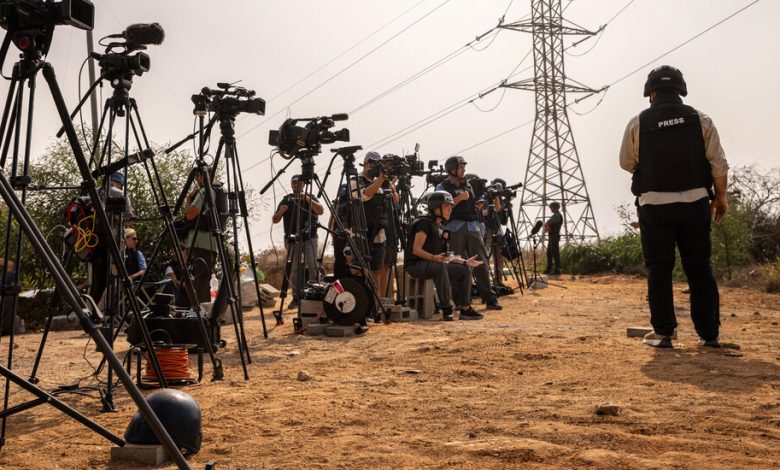Harsh Visuals of War Leave Newsrooms Facing Tough Choices

Gruesome photographs of Palestinian children killed in rocket strikes and Israeli infants murdered by terrorists. Digitally doctored images that whip around social media before they can be verified. Accusations — since rejected by multiple news outlets — that photojournalists had advance knowledge of the Hamas surprise attack on Oct. 7.
The visual chronicle of the war between Israel and Hamas has become its own disturbing case study of the age of disinformation, where photographs, and the act of photojournalism itself, are weaponized by both sides of a highly charged conflict. For newsrooms in the United States and Europe, the question of which images to publish — and which are too graphic or misleading to be published — has rarely been more complex.
“In every war, there is a war of narratives,” said Jonathan Levy, the executive editor of Sky News. “You’ve got to be really mindful, not just of the potential harm to the audience of being exposed to some of that imagery, but also how you manage it.”
In interviews, editors at newspapers, TV stations and wire agencies said they had devoted countless hours in recent weeks to what many said was ultimately a delicate judgment call: deciding what their audiences saw and heard about the war. Among the factors is how much horror a viewer or reader can tolerate, and whether an image sensationalizes or trivializes violence. News outlets also feel a responsibility to victims and their families, who may not be aware that a relative has been killed or badly injured.
“You want to get the most realistic view of what’s happening on the ground; you want to show the pictures,” said Greg Headen, who oversees domestic and international coverage at Fox News. “In many cases, though, we cannot. Some of the images we have seen are so gruesome, they can’t even be described on TV.”
Some footage is so traumatic, Mr. Headen added, that to air it would render viewers numb to the spoken words accompanying the video: “The bottom line is, they’re not going to hear a word your reporter said.”

Scenes like this have been a daily occurrence since the beginning of the war.Credit…Yousef Masoud for The New York Times
War photography has resulted in some of the most indelible images of global conflict, from a flag-raising on Iwo Jima in World War II to a screaming Vietnamese girl burned by napalm. That visceral power is why the Israeli and Hamas authorities, along with their supporters, have used social media and other channels to circulate images intended to rally public sympathy to their side.
In deciding whether to amplify such pictures, news organizations assess their newsworthiness using similar editorial criteria as applied to facts and written reportage. Editors might consider the motivations of the source of the picture, and whether it contributes to a balanced portrayal of events.
“Typically, we really avoid publishing imagery that’s distributed by any kind of state-run agency, because we can’t verify the journalistic integrity of those types of images,” said Meaghan Looram, director of photography at The New York Times. “We’re also always very mindful that any particular state or government has an agenda in the images that they are distributing.”
The logistical hurdles of covering this particular conflict have also created challenges. International journalists have limited access to Gaza, and news outlets have largely relied on local freelance photographers already on the scene. Hamas controls Gaza and places tight restrictions on what reporters can cover. The Israel Defense Forces have escorted some outside journalists into Gaza, but the Israeli military asked to review any photos and footage before publication, which Mr. Levy called “a severe proscription.” Some news outlets have agreed to those terms in order to provide firsthand glimpses of the situation inside Gaza.
Eleven major news organizations, including The Times, wrote to Israeli and Egyptian officials on Monday, formally requesting expanded access into Gaza for their journalists.
Ms. Looram said that she encountered a torrent of images and video posted on social media, but that The Times was unlikely to publish something unless it came from a known and trusted source.
“There are many actors who are trying to disseminate misinformation through imagery, so it just presents a very layered and complicated matrix that’s not straightforward at all,” she said. “Our photo editors, and our video editors and journalists on the ground, are doing our best to properly and accurately represent as much of what is unfolding as is possible.”
As in any war, the question of what to do with intensely violent imagery has generated near-daily debate at news organizations. Rickey Rogers, the global pictures editor for Reuters, said that a group of three top editors decide whether a photograph is respectful to victims and if it furthers the public’s understanding of the conflict. If the victims are children, Reuters seeks parental or guardian consent to use the image. Consent is sometimes impossible to obtain, and the agency may decide to publish anyway if it determines the photo is of overwhelming public interest.
“There are so many photos that are so strong visually, but so graphic, that we do consider them almost unpublishable,” Mr. Rogers said. He gave an example of a photograph of an injured child with a flap of skin hanging from his arm, a victim of the attack on the Al-Shifa Hospital in Gaza. Reuters chose not to publish that image, but the agency published a different photo of the same child that did not show the graphic injury. Other outlets, including the Opinion section of The Times, have published cropped versions of certain photographs, sometimes providing a link to the uncensored image for readers who wish to see it.
The decision by a news organization to publish a particularly shocking image can have large consequences. The 1972 photograph of Kim Phuc Phan Thi, the screaming Vietnamese child, ran on the front pages of many American newspapers, including The Times, shortly after it was taken by Nick Ut, a photographer for The Associated Press.
But the now-famous photograph was almost discarded. Horst Faas, the editor of The A.P.’s Saigon coverage at the time, was the individual who had to decide whether to distribute the image on the news agency’s international wire.
“The girl was obviously nude, and one of the rules was we don’t — at The A.P. — we don’t present nude pictures, especially of girls in puberty age,” Mr. Faas later recalled. But, taken by the power of the photo, he decided to overrule that guideline and publish anyway. The image, later titled “The Terror of War,” won the 1973 Pulitzer Prize for spot news photography.



